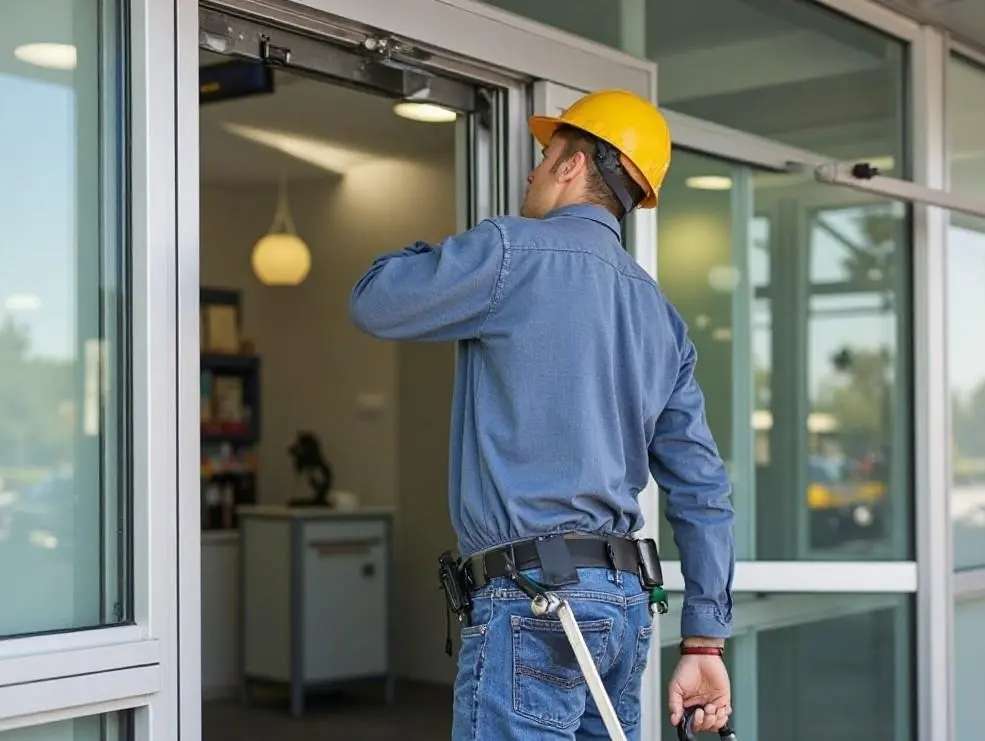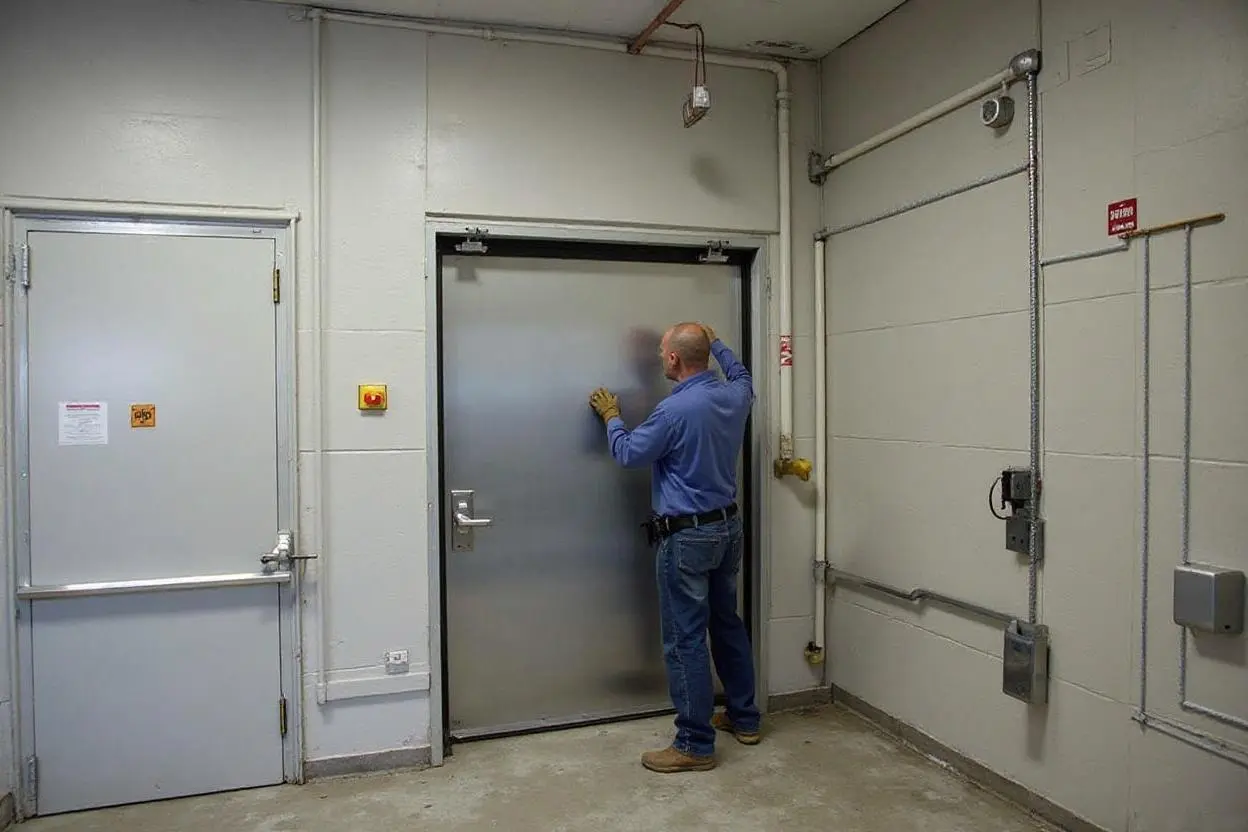The Most Common Automatic Door Sensor Problems and How to Fix Them
Automatic sliding doors live a hard life in Buffalo. Salt spray from winter, lake-effect snow, wind gusts on Delaware Avenue, and heavy foot traffic at Elmwood storefronts all stress sensors and controllers. When a sensor fails, doors hesitate, short-cycle, or stay stuck open, which hurts energy costs and ADA accessibility. Here is what usually goes wrong, how to troubleshoot safely, and when to call A-24 Hour Door National Inc for automatic sliding doors repair Buffalo businesses depend on.
Safety first, every time
Power down the header before touching sensors or wiring. Post a temporary sign and redirect pedestrians. Keep a wedge or stop handy to prevent a moving panel from closing on you. If a door behaves unpredictably or you see damaged glass, do not test further. Call a technician to prevent injury or property damage.
How modern door sensors actually work
Most sliding doors use a mix of active infrared (IR) presence sensors, microwave motion sensors, and safety beams. Motion sensors detect approach by Doppler shift, typically between 10.525 and 24.125 GHz. Presence sensors watch the threshold and hold the door open when an object or person is inside the swing or slide path. Safety beams act as a redundant edge guard. A controller blends these inputs and runs the motor, clutch, and brake with adjustable timing. Knowing which sensor does what helps target the fix.
Symptom: doors stay open and will not time out
This often shows up on windy days in North Buffalo or near building corners in downtown. The controller believes someone is still in the opening.
Likely causes include a presence sensor seeing the floor, a misaligned safety beam, or reflections from wet mats. A fresh floor finish can also trigger IR.
How to check: look at the sensor LEDs. Most brands use a steady LED for “detecting.” If the LED stays on with an empty threshold, angle is wrong or the lens is dirty. Adjust the tilt so the detection field covers the threshold and stops at the floor, not below it. Lift a corner of a mat to break a reflection. For safety beams, confirm the transmitter and receiver are aligned and the indicator changes when you wave a hand through.
Winter note: salt haze on lenses makes IR think it sees movement. Clean lenses with a soft cloth and non-ammonia cleaner. Avoid paper towels, which scratch acrylic.
Symptom: doors hesitate, then snap open late
Buffalo wind can push motion sensors past their range. The microwave unit might be set for too-narrow detection or aimed too high. Nearby refrigerators, metal racks, or moving carts in a deli aisle can also pull the field away from the approach path.
Stand 10 to 12 feet back and walk straight in. If the door opens only when you get within 3 to 4 feet, increase sensitivity one step and angle the antenna down slightly. Aim for consistent opening at 6 to 8 feet for retail and 8 to 12 feet for hospitals. If the unit supports cross-traffic suppression, enable it to reduce side detections from hallways.
Symptom: doors cycle open and closed repeatedly
Short-cycling wastes heat, a real problem during a Lake Erie blast. Common reasons are overlapping sensor zones from both sides of a vestibule, a revolving reflection from glass, or a controller hold-open timer set too short.
Start with timers. Bump the hold-open from 2 seconds to 4 or 5. Next, narrow the motion sensor’s field with the manufacturer’s mask or a small piece of dielectric tape on the lens edge to block the opposing door’s movement. Angle presence sensors so they ignore the moving panel and look only at the threshold. In vestibules on Main Street with facing sliders, reduce sensitivity on the interior unit to prevent it from seeing the exterior door.
Symptom: one panel opens, the other lags
On bi-part sliders, this can be a controller sync issue, debris in the track, or a sensor feeding intermittent signals to one side.
Check the track for grit or screws that have backed out. A quarter-inch stone can stall a panel. Inspect the carriage rollers for flat spots. If the track is clean, swap the left and right sensor plugs at the controller. If the lag moves to the other side, the sensor or its cable is the problem. If the lag stays, look at the motor drive, belt tension, and clutch.

Symptom: door will not open at all
First, confirm power at the header and that the on/off/key switch is in “auto.” Many calls in South Buffalo end with a bumped key switch. If powered, watch the controller LEDs while you walk up. No change means the motion sensor is blind or dead. If the LEDs change but the door does nothing, the issue is on the drive side, not the sensors.
A quick win during snow: clear packed snow and ice from the threshold. Presence sensors refuse to open if they see a solid obstruction.
Dirt and damage: a Buffalo reality
Road salt fogs lenses. Spring pollen sticks to IR covers. Back-of-house doors collect cobwebs that mimic motion. Lenses crack from cart impacts. These mundane issues cause most service calls.
A simple monthly wipe-down prevents many faults. If lenses are crazed or cloudy, replace them. A damaged lens reduces range and causes false holds. For businesses in Kenmore and Cheektowaga where plows kick up brine, weekly cleaning pays off in fewer false detections.
Fine-tuning sensor angles and zones
Proper aim beats cranking sensitivity to maximum. Motion sensors should see approaching traffic from 45 to 60 degrees off the door plane. Presence sensors should create a tight carpet just inside the threshold. Too steep an angle projects into the parking lot. Too shallow misses people with mobility aids who move slowly.
A reliable method: tape a strip on the floor where you want detection to begin. Adjust until the door triggers when a tester’s foot crosses that line from multiple approach angles. Then verify that standing still inside the opening holds the door open without gaps.
Interference from metal, glass, and reflections
Large glass storefronts reflect IR and microwave energy. In the Theater District, mirrored finishes and bright sun through south-facing glass can confuse sensors. Use masks or hooded covers to limit side reflections. Reduce microwave reach by one step in narrow vestibules with glass on both sides. For presence sensors on glossy black floors, switch to a model with background suppression or use a contrasting mat that does not reflect IR.
Wiring, connectors, and water ingress
Header cavities collect condensation during freeze-thaw. Corroded connectors cause intermittent signals that look like random false trips. Tug gently on each Buffalo, NY plug. If a wire feels loose or shows green corrosion, clean and reseat it, then add dielectric grease. Replace cracked grommets. Use drip loops so water does not run into the sensor body.

ADA push plates and touchless sensors
Many Buffalo clinics use touchless wave sensors tied to the automatic operator. If the push plate opens the door but motion sensing does not, troubleshoot the motion unit. If neither works, trace from the plate to the controller. Batteries in wireless transmitters die on a 1 to 3 year cycle. A weak battery can create intermittent opens that look like sensor faults.
Seasonal adjustments matter
Winter coats, hats, and slush slow people down and alter profiles. Presence zones should be a bit wider from November to March. In summer along Elmwood Avenue, set cross-traffic suppression higher to prevent bikes from triggering doors. After any major floor change or mat swap, retune the IR presence zone.
Quick homeowner or store manager checks before calling
- Verify the mode switch is in “auto,” not “hold-open” or “lock.”
- Clean sensor lenses and the safety beam lenses front and back.
- Remove or reposition shiny mats directly under sensors.
- Look for obvious misalignment: crooked sensor heads or beam units.
- Watch the controller LEDs during approach to see which input fails.
If these steps do not restore normal operation, the issue is likely in calibration, wiring, or the drive system. That is the point to bring in a technician.
When repair beats replacement, and when it does not
A sensor that has yellowed, cracked, or lost its gasket will continue to give trouble after cleaning. Replacement is inexpensive relative to the labor of repeat visits. Controllers older than 12 to 15 years may lack modern safety logic and parts availability. For historic storefronts on Hertel Avenue, careful upgrades can preserve the look while improving safety and reliability. A quick site survey can reveal if a targeted sensor swap will solve the issue or if a broader header refresh makes more sense.
Compliance and liability
ANSI/BHMA A156.10 and A156.38 define performance and safety checks for automatic sliding doors. Annual inspections with documented safety tests reduce risk. Many property managers in Buffalo schedule semiannual service: one visit pre-winter to tighten settings and seals, and one in spring to clean, recalibrate, and check wear. This routine helps avoid incidents and unplanned downtime.
Why local service matters in Buffalo
Regional weather and building stock influence sensor behavior. Buildings near the lake see stronger crosswinds. Older masonry entries leak air that moves mats and trips IR. Local technicians recognize these patterns and set sensors accordingly. A-24 Hour Door National Inc stocks sensor heads, lenses, beam units, and controllers that match common systems seen from Amherst to West Seneca, which shortens downtime during an urgent call.
Get dependable automatic sliding doors repair in Buffalo
A malfunctioning sensor costs heat, frustrates customers, and creates safety risk. If a quick clean and aim does not solve it, schedule automatic sliding doors repair Buffalo property managers trust. A-24 Hour Door National Inc offers same-day service for businesses in Buffalo, Tonawanda, Cheektowaga, Lackawanna, and nearby suburbs. The team diagnoses sensor faults, recalibrates zones, replaces damaged lenses and beams, and verifies ADA and ANSI safety. Call to book a visit, or request a maintenance plan that keeps doors reliable through lake-effect winters and busy festival seasons on Elmwood.
A-24 Hour Door National Inc provides commercial and residential door repair in Buffalo, NY. Our technicians service and replace a wide range of entry systems, including automatic business doors, hollow metal frames, storefront entrances, fire-rated steel and wood doors, and both sectional and rolling steel garage doors. We’re available 24/7, including holidays, to deliver emergency repairs and keep your property secure. Our service trucks arrive fully stocked with hardware, tools, and replacement parts to minimize downtime and restore safe, reliable access. Whether you need a new door installed or fast repair to get your business back up and running, our team is ready to help. A-24 Hour Door National Inc
344 Sycamore St Phone: (716) 894-2000 Website: https://a24hour.biz/buffalo
Instagram: @a24hourdoor
Buffalo,
NY
14204,
USA
Facebook: 24 Hour Door
Yelp: A-24 Hour Door National (Buffalo)
X (Twitter): @a24hrdoor